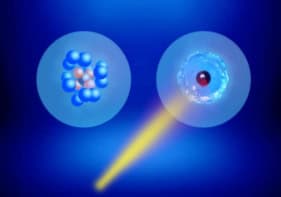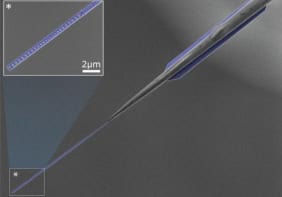A neutral plasma has been cooled to the record-breaking low temperature of 50 mK by Thomas Langin, Grant Gorman and Thomas Killian at Rice University in the US. In the future, ultracold plasmas could provide important insights into the interiors of giant planets and white-dwarf stars – and could even lead to the creation of exotic states of matter such as a solid plasma.
A neutral plasma can be thought of as a cloud of ionized atoms along with the free electrons the atoms have given up. Plasmas are normally hot because it takes a great deal of energy to keep atoms ionized. However, it is also possible to make a cold plasma in which the ions move slowly (and are therefore cold) while the electrons move much more quickly.
Starting about 20 years ago, Killian has been developing techniques for creating ever-colder plasmas from laser-cooled atomic gases. One important goal of his research has been achieved in this latest work – the creation of a strongly-coupled plasma in which electrostatic interactions between ions define the physical properties of the system.
Millions of strontium atoms
Killian and colleagues begin with a gas of about 500 million strontium atoms that is chilled to 1 mK using standard laser-cooling techniques and held in a magnetic trap. The trap is then switched off and the gas allowed to expand for 6 ms before about 10% of the atoms are ionized by a deep-ultraviolet laser pulse. The liberated electrons, which themselves have a temperature of about 15 K, remain in the vicinity of the ions because of electrostatic attraction. As a result, the plasma is electrically neutral to within a few percent. Infrared lasers are then used to cool the ions to temperatures as low as 50 mK.
An important thermodynamic parameter describing plasmas is the ratio of the electrostatic repulsion between the ions to the kinetic energy of the ions. In these ultracold plasmas, Killian explains, the interactions between ions are more important for defining the properties of the plasma than are the motions of the ions – the hallmark of a “strongly coupled plasma”
Distant worlds
It turns out that this ratio is roughly the same for the high-temperature, high-pressure plasmas that are currently being used in the laser-driven ignition of nuclear fusion. A similar ratio is also found within giant planets such as Jupiter and white-dwarf stars where the crushing force of gravity pushes hydrogen atoms so close together that they form a hot, dense plasma. As a result, ultracold plasmas could be used as simulators that could boost the development of fusion energy sources and improve our understanding of stars and planets.
“We can’t study strongly coupled plasmas in places where they naturally occur,” Killian says. “Laser cooling neutral plasmas allows us to make strongly coupled plasmas in a lab, so that we can study their properties.”
“Strongly coupled ions can’t be near one another, so they try to find an arrangement where the repulsion from all of their neighbours is balanced,” adds Killian. “This can lead to strange phenomena like liquid or even solid plasmas, which are far outside our normal experience.”
The research is described in Science.



